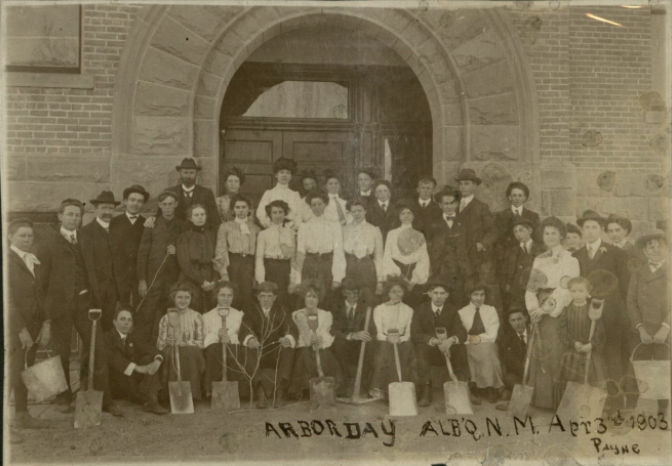
Arbor Day’s Roots in the University Of New Mexico
1905
The University of New Mexico would not be the place it is today without the over five thousand trees that decorate its campus. It all started in 1905 when university President William G. Tight, faculty, and students collected and planted Ponderosa Pines from the Sandia Mountain Range in a grove behind Hodgin Hall. Tight believed the beautiful landscape developed by these volunteers would “foster a better academic environment” for everyone. Eventually known as Tight’s Grove, these statuesque pines are now the oldest trees on campus, said to be over one hundred years old. These towering evergreens at the corner of Central and University were some of the first to transform a bleak desert scape into a lush oasis.
A university is like a grove of saplings. Students reap what they sow through hard work, and gain the knowledge and training they need eventually to reap monumental rewards. Arbor Day at UNM reinforces this concept by planting trees every year, most of which the university purchases from donations collected in a jar at the UNM bookstore. In 1994, the State of New Mexico designated the UNM campus an arboretum and provided protections for its over two-hundred species of trees. Arbor Day has brought some interesting attention to UNM such as being gifted a sapling grafted from a tree in the Smithsonian Mall in Washington DC. The university even won the ISA Gold Leaf award for a mass planting in 2013. Tree planting became more efficient as the University started focusing on sustainability. UNM’s Physical Plant uses trees with wide leaves in strategic locations to cool buildings in the summer and allow heat to warm the buildings when the leaves fall. They upgraded the irrigation system to conserve water, an important consideration when planting a forest in the middle of the desert.
Trees and nature have a profound effect on student success by promoting good mental health. As stated in a UNM Staff Council press release, “tree filled areas foster healthy communities by reducing stress on the human body and mind.” Trees make us happier and promote cleaner air quality. Nature calms the mind and fosters creativity, which is vital to the university environment. One of the Arbor Day press releases from 2014 boasts 31 tons of carbon dioxide removed by each tree and a further 458 pounds of other air pollutants. UNM’s facilities and their arborists work diligently to maintain the fragile groves around campus. The organizations responsible for Arbor Day are the UNM Facilities, the UNM Physical Plant, the UNM Sustainability Department, and the Staff Counsel Environment Committee. Maintaining five thousand trees is no easy task so they use sophisticated software to archive and catalog the trees. As a result, of diligent care though, UNM’s trees live much longer and grow much bigger than average urban trees. The largest tree on campus is a Siberian Elm, which is over 80 feet tall.
You can find a walking tour of UNM’s Arboretum here.
Rory D. Thomas, Liberal Arts, 2019
Further Reading:
"Tight Grove” http://pdc.unm.edu/strategic-leadership/university-landscape-architect/HeritageZone-Tight.pdf
“UNM Staff Council celebrates Arbor Day at HSC”, March 14 2014,>http://hscnews.unm.edu/in-brief/unm-staff-council-celebrates-arbor-day-at-hsc, Karen Wentworth.
"Facilities Management announces Earth Day and Arbor Day activities for April." US Official News, 13 Apr. 2019. Gale OneFile: News, https://link.gale.com/apps/doc/A582367461/STND?u=albu78484&sid=STND&xid=5aabc277. Accessed 3 Oct. 2019.
"UNM Wins a ISA Gold Leaf Award”, November 04 2013, / https://news.unm.edu/news/unm-wins-an-isa-gold-leaf-award, Rachel Stone.
“UNM Arborists Inventory Campus Trees”, May 08/2014, https://news.unm.edu/news/unm-arborists-inventory-campus-trees, Rachel Stone.
"UNM Takes Measures to Conserve Water”, June 12/2013, http://www.unm.edu/features/2013/unm-takes-measures-to-conserve-water.html, Carolyn Gonzales.
Photo: Arbor day 1903, Photo courtesy of the Center for Southwestern Research, University of New Mexico. Richard W.D. Bryan Collection Photographer, Payne
